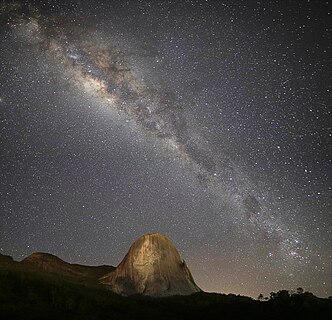Commons:Featured picture candidates/File:PEDRA AZUL - ES - VITOR B. BARBOSA - FOTO 02.jpg
Jump to navigation
Jump to search
File:PEDRA AZUL - ES - VITOR B. BARBOSA - FOTO 02.jpg[edit]
Voting period is over. Please don't add any new votes.Voting period ends on 27 Oct 2023 at 10:44:12 (UTC)
Visit the nomination page to add or modify image notes.
- Gallery: Commons:Featured pictures/Astronomy#Sky
 Info Pedra Azul (Blue Stone) peak with the center of the Milky Way above it. Pedra Azul State Park is a state park in Domingos Martins, Espírito Santo, Brazil. Created and uploaded by VITORBBARBOSA - nominated by ★ -- ★ 10:44, 18 October 2023 (UTC)
Info Pedra Azul (Blue Stone) peak with the center of the Milky Way above it. Pedra Azul State Park is a state park in Domingos Martins, Espírito Santo, Brazil. Created and uploaded by VITORBBARBOSA - nominated by ★ -- ★ 10:44, 18 October 2023 (UTC) Support Another spectacular astronomical view of the Blue Stone! -- ★ 10:44, 18 October 2023 (UTC)
Support Another spectacular astronomical view of the Blue Stone! -- ★ 10:44, 18 October 2023 (UTC) Comment Why there's a white line around the picture? - ABAL1412🇻🇳🇸🇺🇷🇺 (talk ☭) 17:44, 18 October 2023 (UTC)
Comment Why there's a white line around the picture? - ABAL1412🇻🇳🇸🇺🇷🇺 (talk ☭) 17:44, 18 October 2023 (UTC)
- Oops… I hadn't seen it before; anyway,
 Removed. ★ 18:14, 18 October 2023 (UTC)
Removed. ★ 18:14, 18 October 2023 (UTC)
- Oops… I hadn't seen it before; anyway,
 Oppose I wouldn't be upset if others considered this photo good enough to feature per se, but the other one has better quality on land and in the sky, more vivid colors, and a better composition, so I think though this one is good, it should probably just be a QI. -- Ikan Kekek (talk) 22:29, 18 October 2023 (UTC)
Oppose I wouldn't be upset if others considered this photo good enough to feature per se, but the other one has better quality on land and in the sky, more vivid colors, and a better composition, so I think though this one is good, it should probably just be a QI. -- Ikan Kekek (talk) 22:29, 18 October 2023 (UTC) Neutral Upon initial observation, one can discern the ramifications of a potentially overextended integration time, exacerbating the star elongation, particularly noticeable in the declination drift, perhaps indicative of an imprecise polar alignment or slight periodic error in the mount's right ascension axis. The granularity in the dark nebulae sections of the Milky Way suggests an ISO setting that might have ventured beyond the camera sensor's optimal signal-to-noise ratio, possibly pushing past its unity gain. The absence of tight, pinpoint star colors may also indicate chromatic aberration, a telltale sign of optics that could benefit from improved apochromatic elements or the addition of a field flattener. The terrestrial component's unnatural luminance gradient might be a repercussion of errant white balance settings, perhaps leaning towards a kelvin value not best suited for the prevalent light pollution spectrum—possibly sodium vapor or LED influences. It would have been advantageous to employ multi-bandpass filters, especially if this is an OSC (One Shot Color) sensor, to isolate specific emission lines and negate the aforementioned ambient light distortions. IMHO, there appears to be a lack of stacked subs, as evidenced by the diminished signal differentiation in the H-alpha and H-beta regions of the Milky Way. Employing dithering between subs might have mitigated some of the fixed-pattern noise present. --Wilfredor (talk) 23:34, 18 October 2023 (UTC)
Neutral Upon initial observation, one can discern the ramifications of a potentially overextended integration time, exacerbating the star elongation, particularly noticeable in the declination drift, perhaps indicative of an imprecise polar alignment or slight periodic error in the mount's right ascension axis. The granularity in the dark nebulae sections of the Milky Way suggests an ISO setting that might have ventured beyond the camera sensor's optimal signal-to-noise ratio, possibly pushing past its unity gain. The absence of tight, pinpoint star colors may also indicate chromatic aberration, a telltale sign of optics that could benefit from improved apochromatic elements or the addition of a field flattener. The terrestrial component's unnatural luminance gradient might be a repercussion of errant white balance settings, perhaps leaning towards a kelvin value not best suited for the prevalent light pollution spectrum—possibly sodium vapor or LED influences. It would have been advantageous to employ multi-bandpass filters, especially if this is an OSC (One Shot Color) sensor, to isolate specific emission lines and negate the aforementioned ambient light distortions. IMHO, there appears to be a lack of stacked subs, as evidenced by the diminished signal differentiation in the H-alpha and H-beta regions of the Milky Way. Employing dithering between subs might have mitigated some of the fixed-pattern noise present. --Wilfredor (talk) 23:34, 18 October 2023 (UTC)
- Wilfredor, please stop with the AI generated reviews. Your own words should be here, not those concocted by a machine. --Cart (talk) 09:41, 19 October 2023 (UTC)
 I withdraw my nomination ★ 13:28, 20 October 2023 (UTC)
I withdraw my nomination ★ 13:28, 20 October 2023 (UTC)
